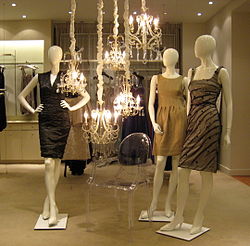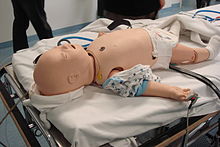- Mannequin
-
For other uses, see Mannequin (disambiguation).
 Mannequins in a clothing shop, in Canada
Mannequins in a clothing shop, in Canada
A mannequin (also called a dummy, lay figure or dress form) is an often articulated doll used by artists, tailors, dressmakers, and others especially to display or fit clothing. The term is also used for life-sized dolls with simulated airways used in the teaching of first aid, CPR, and advanced airway management skills such as tracheal intubation and for human figures used in computer simulation to model the behaviour of the human body. During the 1950s, mannequins were used in nuclear tests to help illustrate the effects of nuclear weapons on human beings.[1][2]
Mannequin comes from the French word mannequin, which had acquired the meaning "an artist's jointed model", which in turn came from the Middle Dutch word mannekijn, meaning "little man, figurine".[3]
Contents
History
Shop mannequins are derived from dress forms used by fashion houses for dress making. The use of mannequins originated in the 15th century, when miniature "milliners' mannequins" were used to demonstrate fashions for customers.[4] Full-scale, wickerwork mannequins came into use in the mid-18th century.[4] Wirework mannequins were manufactured in Paris from 1835.[4]
Shop display
The first fashion mannequins, made of papier-mâché, were made in France in the mid-19th century.[4] Mannequins were later made of wax to produce a more lifelike appearance. In the 1920s, wax was supplanted by a more durable composite made with plaster.[5]
Some modern mannequins are made of molded plastic. Mannequins are used extensively for the display of clothing in stores and in shop windows, and as decoration.
Use by artists
Historically, artists have often used articulated mannequins as an aid in drawing draped figures. The advantage of this is that clothing or drapery arranged on a mannequin may be kept immobile for far longer than would be possible by using a living model.
Medical education
 A baby medical simulation mannequin
A baby medical simulation mannequin
Medical simulation mannequins, models or related artefacts such as SimMan[6] or Harvey[7] are widely used in medical education.[8] These are sometimes also referred to as virtual patients.
In first aid courses mannequins may be used to demonstrate methods of giving first aid (e.g., resucitation).
Emergency services training
See also: manikinFire and coastguard services use mannequins to practice life-saving procedures. The mannequins have similar weight distribution to a human. Special obese mannequins and horse mannequins have also been made for similar purposes.
In popular culture
Mannequins were a frequent motif in the works many early 20th-century artists, notably the Metaphysical painters Giorgio de Chirico, Alberto Savinio, and Carlo Carrà.[9][10] Shop windows displaying mannequins were a frequent photographic subject for Eugene Atget.[5]
Mannequins are a common theme in horror fiction. Many people find mannequins disturbing (due in part perhaps to the uncanny valley effect), especially when not fully assembled. Abandoned nuclear test sites consisting of entire towns populated by mannequins appear in such films as Kalifornia, Mulholland Falls, and the 2006 remake of The Hills Have Eyes.
See also
- Agalmatophilia, sexual attraction to mannequins
- CPR
- Crash test dummy
- Model
- Pediophobia, irrational fear of mannequins
- Resusci Anne
- Sex doll
References
- ^ "Nuclear Test Mannequins". Seattle Times Trinity Web. Seattle Times Company. 1995. http://seattletimes.nwsource.com/special/trinity/photopages/mannequins_dinner.html.
- ^ Trivedi, Bijal P. (15 July 2002). "Archaeologists Explore Cold War Nuclear Test Site". National Geographic News. http://news.nationalgeographic.com/news/2002/07/0708_020710_TVnucleararchae_2.html.
- ^ "mannequin". The American Heritage Dictionary of the English Language. Houghton Mifflin Company. 2004. http://dictionary.reference.com/browse/mannequin. Retrieved 2009-08-07.
- ^ a b c d Steele, Valerie (ed.). Encyclopedia of Clothing and Fashion. Vol. 2. Detroit: Charles Scribner's Sons, 2005. p. 377
- ^ a b Steele, Valerie (ed.). Encyclopedia of Clothing and Fashion. Vol. 2. Detroit: Charles Scribner's Sons, 2005. p. 379
- ^ "SimMan". Laerdal. http://www.laerdal.com/document.asp?docid=1022609.
- ^ "Harvey: Major Changes". Gordon Center for Research in Medical Education. http://www.crme.med.miami.edu/harvey_findings.html.
- ^ Cooper Jeffery B, Taqueti VR (2008-12). "A brief history of the development of mannequin simulators for clinical education and training". Postgrad Med J. 84 (997): 563–570. doi:10.1136/qshc.2004.009886. PMID 19103813. http://pmj.bmj.com/content/84/997/563.long. Retrieved 2011-05-24.
- ^ Holzhey, Magdalena. 2005. Giorgio de Chirico 1888–1978 the modern myth. Koln: Taschen. pp. 42–43. ISBN 3822841528
- ^ *Cowling, Elizabeth; Mundy, Jennifer. 1990. On Classic Ground: Picasso, Léger, de Chirico and the New Classicism 1910-1930. London: Tate Gallery. p. 54. ISBN 1-854-37043-X
- Gross, Kenneth - The Dream of the Moving Statue (Penn State Press 1992, ISBN 0-271-02900-5)
External links
Categories:- Dutch loanwords
- Art materials
- Dummies and mannequins
Wikimedia Foundation. 2010.


